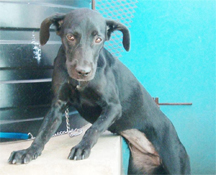Continued
Last year on December 13, 2009, we discussed the various possible causes of pharyngitis (the consequence of infectious diseases, inflammation of nearby tissues, extension of a rhinitis, air pollutants, unskilled administration of oral medicine, the eating of hot food, genetic defects, etc).
 Now let’s have a look at the tell-tale signs associated with this malady.
Now let’s have a look at the tell-tale signs associated with this malady.
Symptoms
● Obviously, if the back of the throat is inflamed, there is going to be severe pain resulting therefrom. The animal with pharyngitis will therefore ingest food slowly or not at all. This is usually the first sign.
● If the pain is really severe, the animal would not even drink water. Signs of dehydration may appear (elasticity of the skin is reduced).
● If the owner were to touch the outer area of the pharynx, the dog would react immediately to the pain.
● There may be an accompanying swelling (and even pain) of the lymph nodes in that general area. The tonsils (lymph nodes) may also be red and swollen.
● In severe cases the lymph tissue in the back of the throat can become so swollen that breathing becomes coarse and raspy.
●Very often, a laryngitis may accompany the pharyngitis. In this case, you may provoke a slight cough if you squeeze the pharyngeal area.
● If the pain inhibits the swallowing reflex, even the salva, instead of being swallowed, will drool out of the mouth. Also, the pain and inflammation could cause vomiting and coughing. When the dog is subjected to such spasms, the vomited material could end up in his lungs (aspiration pneumonia).
● Fever, especially when there is great infection of the pharynx.
● The dog usually shows some nasal discharge.
● Stiffness of the neck.
● Impaired breathing (respiratory distress) in advanced cases – especially if the dog has been subjected to strenuous activity.
NB (i) The worst thing that can happen in a severe pharyngitis attack is the development of an oedema (tissue swollen with fluid). This could lead to suffocation, as the swollen tissue blocks the air from going easily into the lungs.
(ii) In some cases, the dog (because of pain) will not open its mouth for you to look in. In such cases, the vet may have to sedate/anaesthetize the dog in order to have a peek at the pharyngeal area.
Treatment

- This sad-looking female dog (she has been spayed) has not completely lost hope that some kind person will offer her a home in this New Year. She is waiting at the GSPCA.
As usual, the treatment should mirror the cause of the problem. For example, if the pharyngitis has been provoked by a mechanical trauma (some foreign body stuck in the throat), then we must remove the offending object. I tend to support the actual removal of the object with a follow-up antiseptic solution. Some practitioners might wish to suggest that one uses expectorants as part of the therapy. Expectorants are drugs which assist in the removal of secretions from the air passages, especially since a lot of mucus build-up can take place in severe pharyngitis cases. I personally tend not to implement such regimes because some expectorants can precipitate vomiting. Other drugs that can be used to ‘paint’ the back of the throat are iodine in glycerine or a silver nitrate solution or Lugol’s solution.
I would introduce penicillin-based antibiotics (or sometimes sulfonamides), if the conservative local treatment is not showing quick improvement. For the pain, I tend to prescribe aspirin.
It is imperative that we do not feed an animal with a throat ailment any hot, hard foods. In the case of pharyngitis, liquid foods are compulsory. In fact, if the inflammation is bad enough, I would feed the animal intravenously.
Laryngitis
I had promised to write about laryngitis this week. However, space will not permit us to deal with this matter comprehensively and as one whole topic. Next week we’ll deal with this inflammation of the larynx (the organ of the voice, which also forms part of the air passage).
Allow me to again wish the companion animal care-givers, throughout Guyana and abroad, all the very best during 2010.
Please implement disease preventative measures (vaccinations, routine dewormings, monthly anti-heartworm medication, etc) and adopt-a-pet from the GSPCA’s Animal Clinic and Shelter at Robb Street and Orange Walk, if you have the wherewithal to care well for the animals. Do not stray your unwanted pets, take them to the GSPCA’s Clinic and Shelter instead. If you do not wish your pet to have puppies or kittens, you may exploit the GSPCA’s free spay and neutering programme. If you see anyone being cruel to an animal, or if you need any technical information, please get in touch with the Clinic and Shelter by calling 226-4237.
